Finding Inspiration at Mount Auburn Cemetery
“We stand, as it were, upon the borders of two worlds; and as the mood of our minds may be, we may gather lessons of profound wisdom by contrasting the one with the other,or indulge in the dreams of hope and ambition…”
– Joseph Story, Mount Auburn Cemetery, 1831 Consecration Address
Roberto Mighty is Mount Auburn’s first artist-in-residence. A new media filmmaker, photographer, and sound designer, Mighty will be documenting the conservation of the Amos Binney monument and creating a short film about the project and the monument’s history as part of our IMLS grant. Follow his progress by clicking the ‘Artist in Residence’ tag.
“I believe that Mount Auburn, if not a poem, is a book, a book we can never tire of reading. Its themes are those of all great literature— time, love, loss, war, and nature.”
— Celia Gilbert, poet, speaking at the 175th Anniversary of Mount Auburn’s Consecration
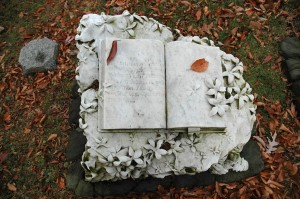
The unique relationships between Mount Auburn and the public it serves have long been reflected in poetry, prose, and lore. For decades writers have drawn upon Mount Auburn’s most timeless and universal themes.
~
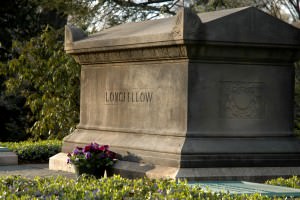
Poet Henry Wadsworth Longfellow:
Commemorations on Family and Friends
Before Longfellow came to be buried at Mount Auburn in 1882, he experienced the deaths of several close family and friends. Longfellow, known as the poet of “Hope, Home and History,” celebrated his own experiences—both good and bad—in poetical verse. Read a few poems that Longfellow wrote in memory of friends and family.
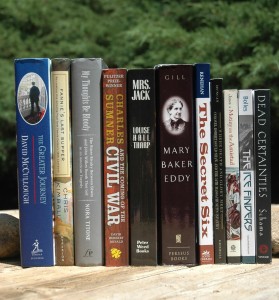
Mount Auburn Book Club
Since 2008, the Mount Auburn Book Club has met to discuss books written by or about individuals buried at Mount Auburn, include scenes that take place in Mount Auburn, or discuss any of the variety of topics that relate to the Cemetery. The club meets the second Thursday of every month in Story Chapel at 10 AM and new members are most welcome! Mount Auburn Books of Interest
16 year old Emily Dickinson visits Mount Auburn in 1846
She wrote to a friend: “Have you ever been to Mount Auburn? If not you can form but slight conception – of the ‘City of the dead.’ It seems as if Nature had formed the spot with a distinct idea in view of its being a resting place for her children, where wearied & disappointed they might stretch themselves beneath the spreading cypress & close their eyes ‘calmly as to a nights repose or flowers at set of sun.”
(Emily Dickinson Selected Letters, ed. Thomas H. Johnson, Belknap Press, 1971)Poet Robert Creeley writes of Mount Auburn
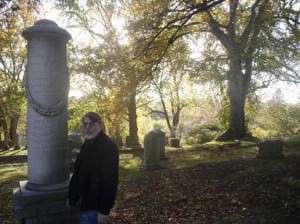
“…Tulip Path, hard
to find on the
shaft, that insistent
rise to heaven
goes down and down…”
– Robert Creeley (Lot 1509 Tulip Path)
Poet Lawrence Ferlinghetti was so inspired by a visit to friend and fellow poet Robert Creeley’s grave at Mount Auburn, that he wrote two poems about his experience at the Cemetery. “In the Creeley family plot in Mount Auburn Cemetery, just off the Tulip Path, there were already thirteen Creeleys with their names incised in a twelve-foot stone pillar, and poet Robert Creeley now just buried here…” read more
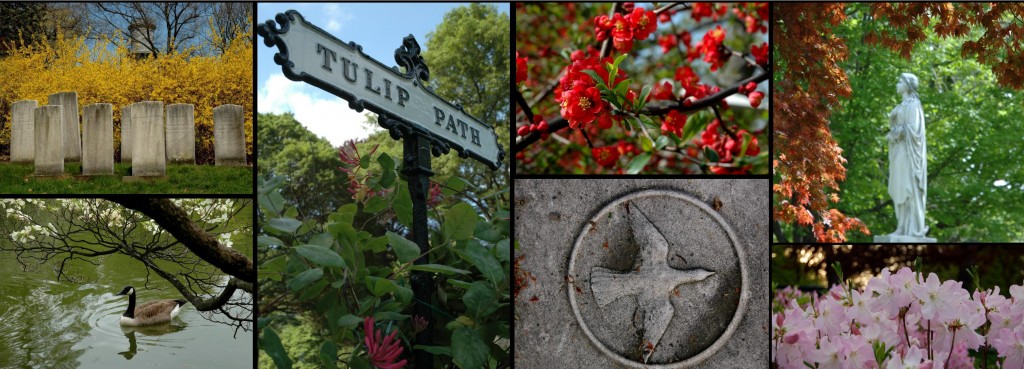
Mount Auburn: 180+ years of evolving ideas about life and death
The Winter 2013 issue of Sweet Auburn Magazine celebrated a small selection of work the Cemetery has helped to inspire, reflecting 181 years of evolving ideas about life, death, and the Mount Auburn itself. In our printed magazine we highlighted, “The New Adam and Eve” by Nathaniel Hawthorne, “The First Snowfall” by James Russell Lowell, The Late George Apley by John P. Marquand, “Stairway to Heaven” by Robert Creeley, Still Alice by Lisa Genova and Lanie by Jane Kurtz. Nevertheless, many other literary works have drawn inspiration from the Cemetery, including:
“Incident at Mount Auburn” from Fern Leaves from Fanny’s Portfolio by Fanny Fern
An excerpt from Fern’s 1853 short story reads, “A mother had laid her darling in the earth. Many mothers have done this; it is an everyday occurrence. Myriads of little sculptured forms have been thus laid to rest, with blinding tears…In all the wide earth there is no spot so dear as the little mound that covers a child…Friends and acquaintances accompany them to “the narrow door,” and there they leave them.”
Author and newspaper columnist Fanny Fern (1811 – 1872) is buried in Lot 994 Eglantine Path at Mount Auburn.
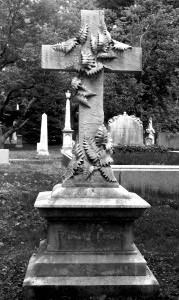
Escher Twist by Jane Langton, 2002
“I’m trying to remember why I chose to use Mount Auburn in Escher Twist. I suppose it was simply that since I write mysteries about death and general gloom, and since Homer Kelly hails from this territory, Mt. Auburn was a natural choice.” – Jane Langton, on Mount Auburn as a setting for the Escher Twist
In the opening to her book Escher Twist, Langton describes Cambridge, Massachusetts in “a fantastical statistical study.” She writes, “Like most cities, Cambridge is not one metropolis but many” and continues, “Six-and-a-half square miles of urban density relieved by parks and playing fields and by a famous cemetery….[and] in taking a proper census, what about underground residents? Shouldn’t they be included in the total population by some sort of mortuary statistic? After all, there are ninety-thousand expired citizens in Mount Auburn alone…”
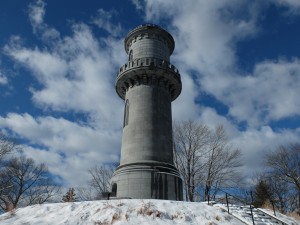
Hatching Magic by Ann Downer, 2003.
From Hatching Magic (p.20):
“They drove to Mount Auburn, the big Victorian cemetery not far from Harvard Square. Mikko parked the car, and they walked up the path to their favorite duck pond, passing graves marked with marble urns, lambs, obelisks, rose-covered crosses, melancholy angels, and even tiny Greek temples. For a cemetery, Mount Auburn really wasn’t very spooky, with the sunlight filtering through the branches of the huge, old chestnuts and oaks and robins bounding along on the brilliant green carpets of grass between the graves.”

Mansions of the Dead by Sarah Stewart Taylor, 2004.
From Mansions of the Dead (p. 210):
“But these stones were different from his father’s. They were in the shapes of things, coffins or pyramids or angels, and they had beautiful flowers carved on them. As he wandered along the rows, reading the names on the stones, he recognized some of them from buildings he’d see around town, street names.
He stopped in front of a small statue of an angel, inscribed with the words, “My Wife and Child.” That was it, no names, no dates. He stood for a moment, reading the words, conscious that his eyes were filling up, and embarrassed, he wiped them away.”

Crashing Eden by Michael Sussman, 2012
“Mount Auburn Cemetery has always been one of my favorite places in Cambridge, as I consider it the most peaceful and beautiful spot in the entire city. So I set no less than three scenes at the cemetery in my new fantasy/science fiction novel, Crashing Eden. Joss Kazdan, the teenage protagonist of the story, feels partly to blame for the death of his younger brother, Eli. Joss visits his brother’s grave with his family, and later on his own, trying to come to terms with his loss.” – Michael Sussman on Mount Auburn Cemetery
An excerpt from Crashing Eden’s first scene:
“She pulled into Mount Auburn Cemetery and crawled through its web of narrow roads. Before Eli died, I used to love to stroll through the cemetery each spring, its rolling hills covered with lush foliage, a refuge for dozens of bird species. Now, on this chilly overcast afternoon, it felt dismal and forlorn.”
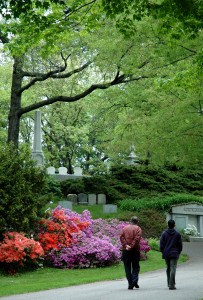
Sightseers were once introduced to Mount Auburn through a series of guidebooks. The volumes proved immensely popular, taking visitors of the time on detailed tours of the Cemetery. Today the guidebooks provide us with a wealth of information about the 19th-century rural cemetery landscape.
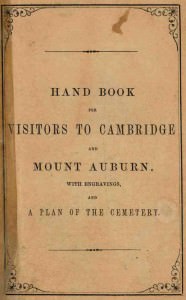
View A Hand-Book For Passengers over the Cambridge Railroad With A Description Of Mount Auburn
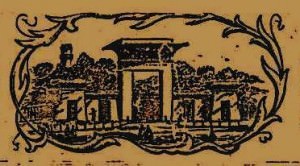
Mt. Auburn Memorial was a weekly newspaper that discussed many topics related to Mount Auburn. The eight page publication was produced by Mount Auburn’s gatekeeper, Truman Hopson (T.H.) Safford, and his son DeForest (D.F.) Safford.
The first edition was published on June 15, 1859 – features included poems, stories, news from other cemeteries, advertisements for local services, horticulture notes, record of interments, memorials to notable residents and more. View scans of poems printed in Mt. Auburn Memorial.
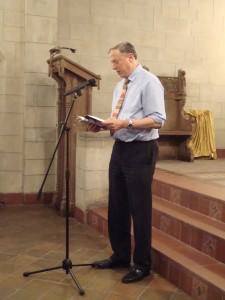
In celebration of National Poetry Month Mount Auburn has hosted a couple of Coffeehouse events. Area poets, writers, and musicians gathered at the Cemetery to perform pieces inspired by Mount Auburn and related subjects. Among our performers have been several published poets and popular musicians from the local folk circuit.
View photos and video from the event.
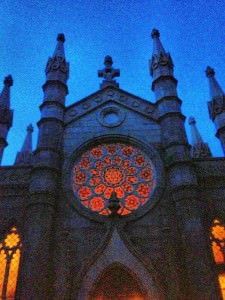
More than 200,000 visitors come to Mount Auburn each year to visit the graves of those buried here, participate in our programs, explore our many facets, and commune with nature. A large percentage of our visitors now arrive with cameras as well as camera equipped cell phones and we love it when they share their photos with us!
Take a look at some of the fantastic photos taken by Mount Auburn visitors on our Flickr and Pinterest pages!
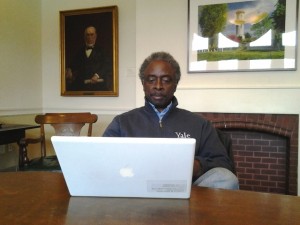
Leave a Reply